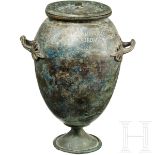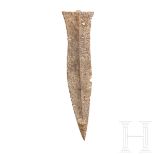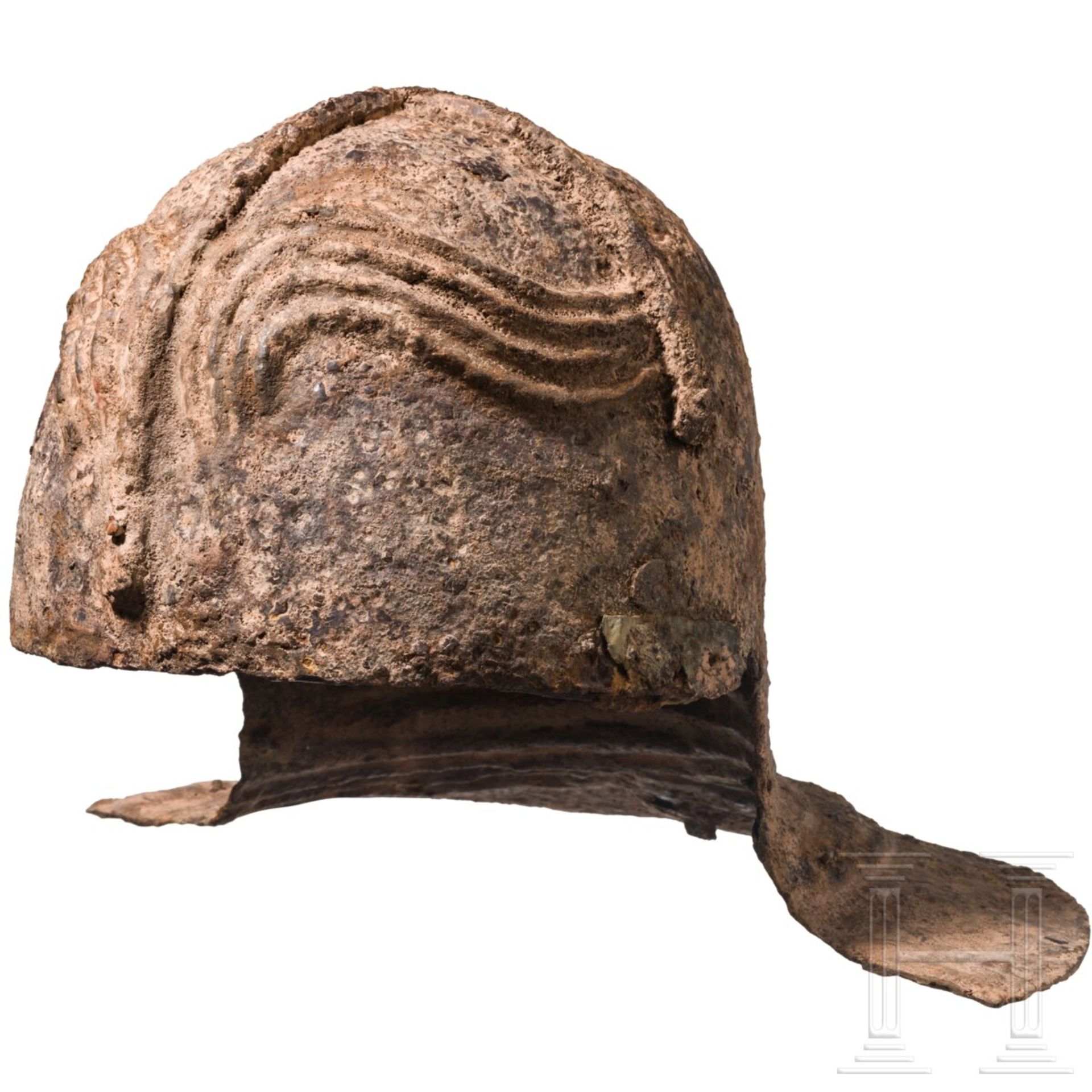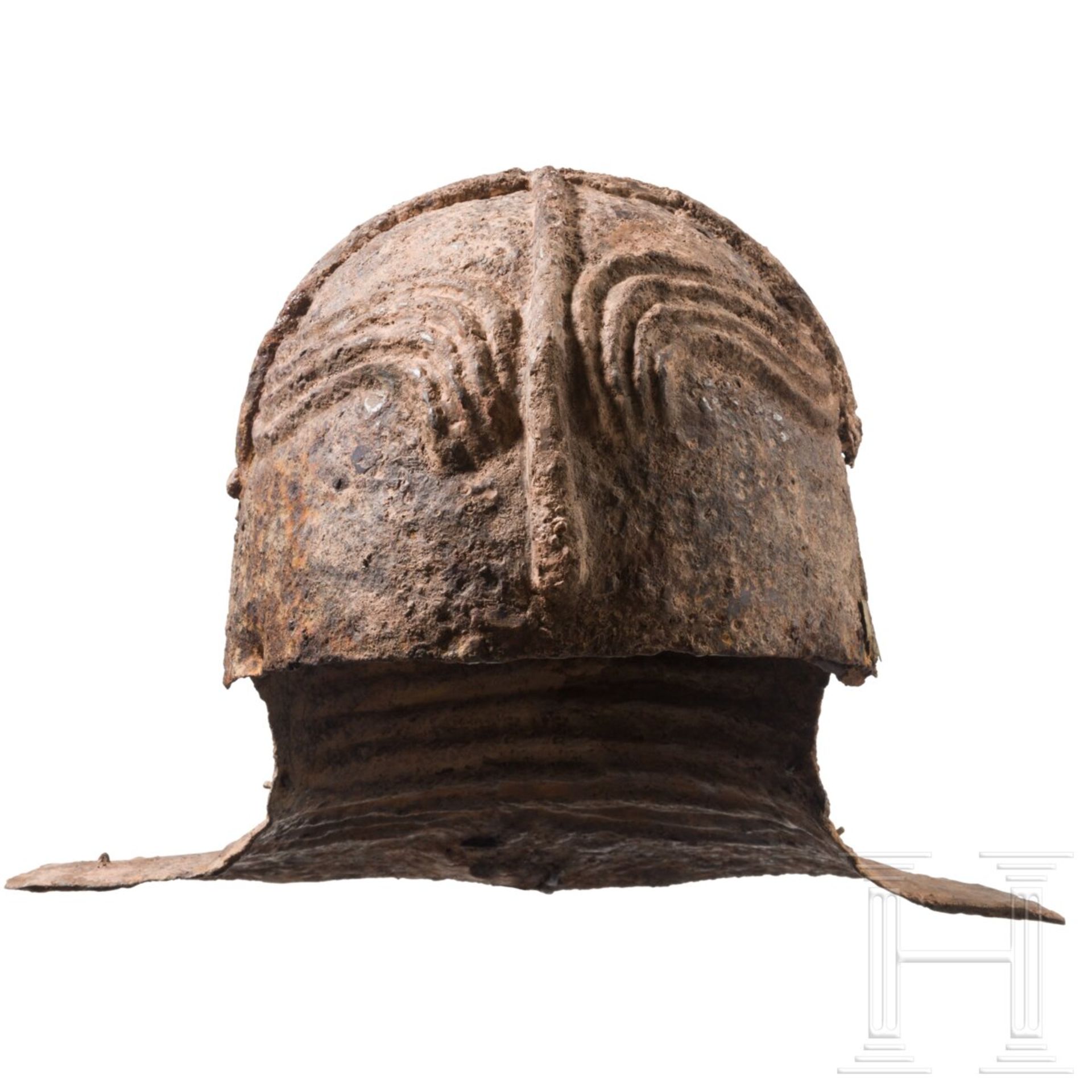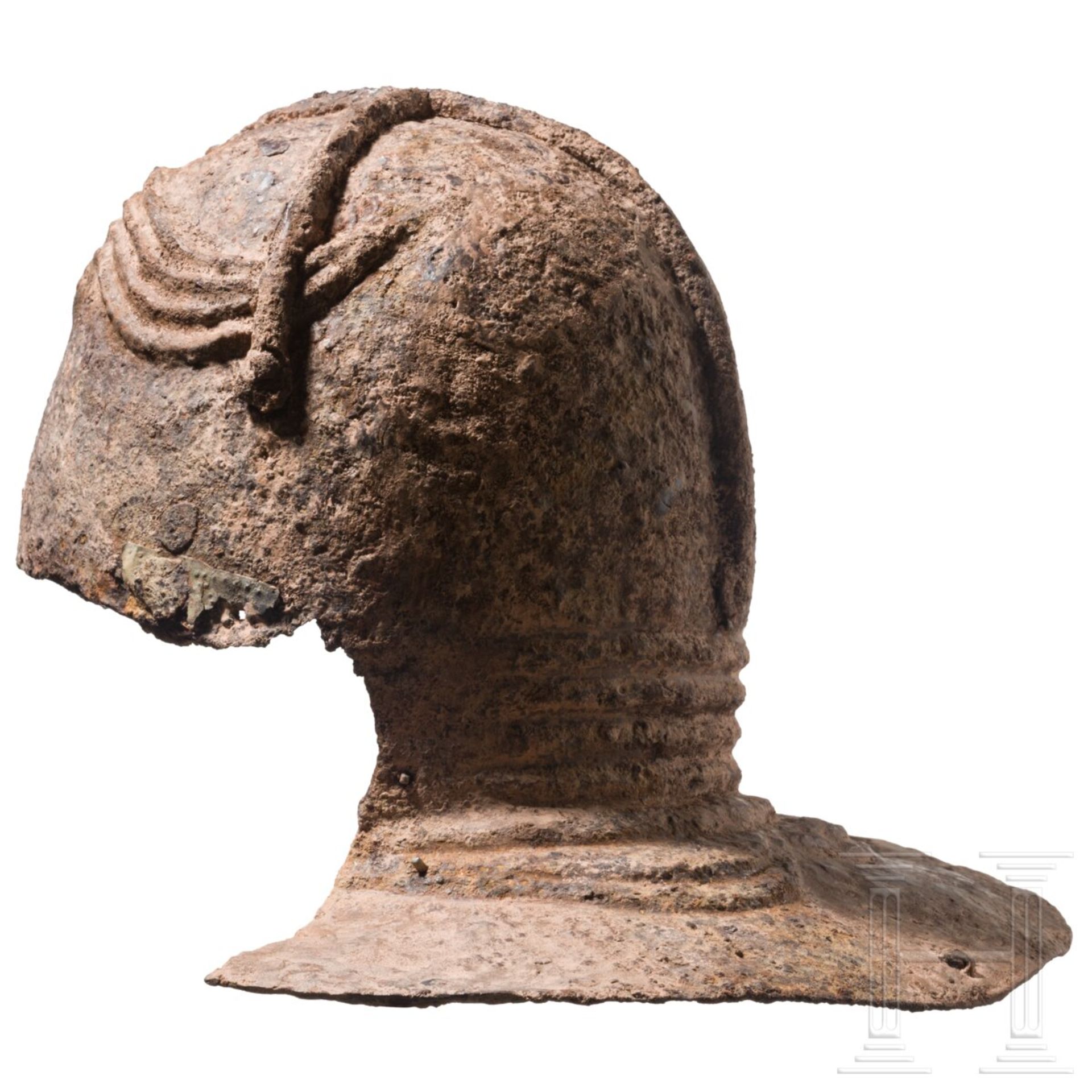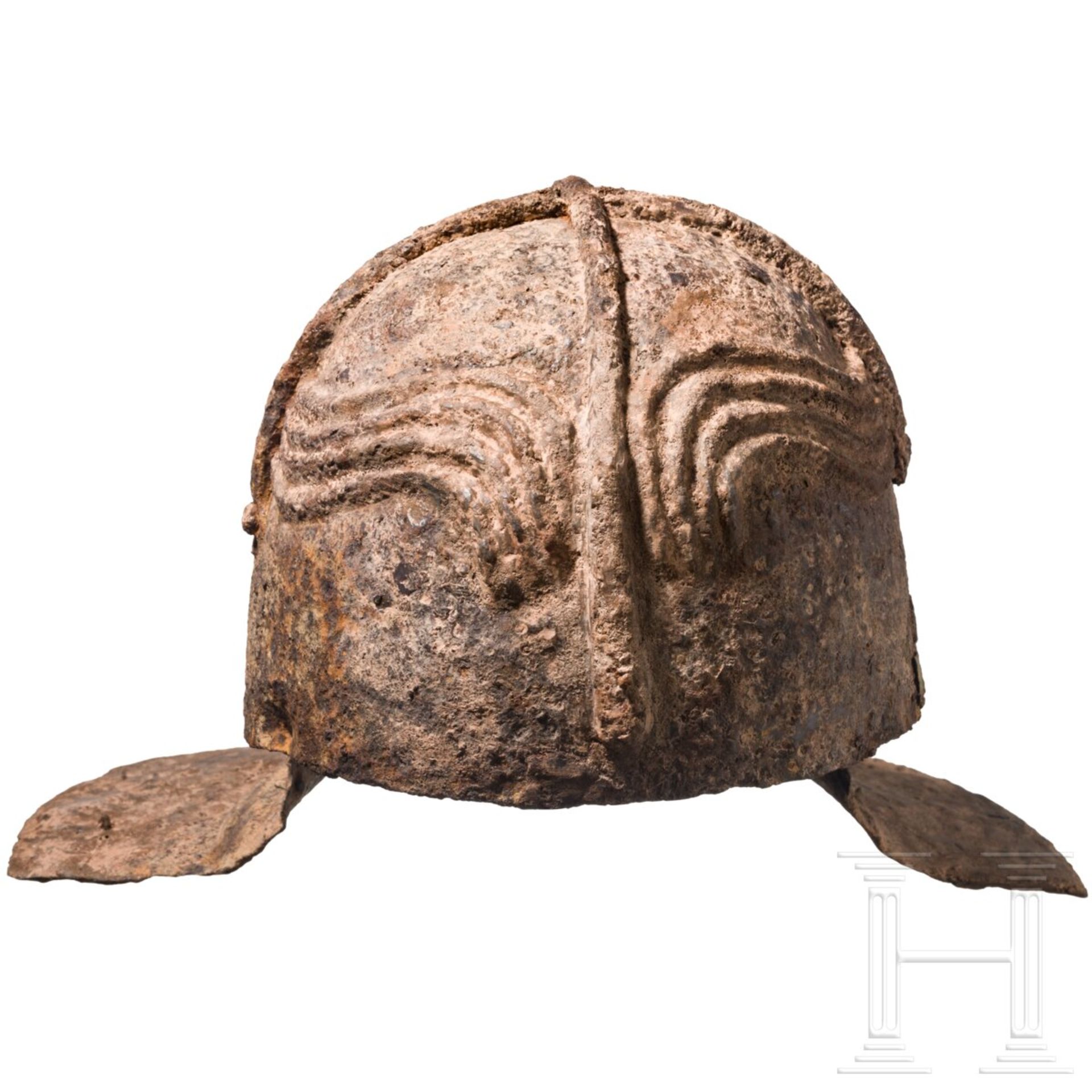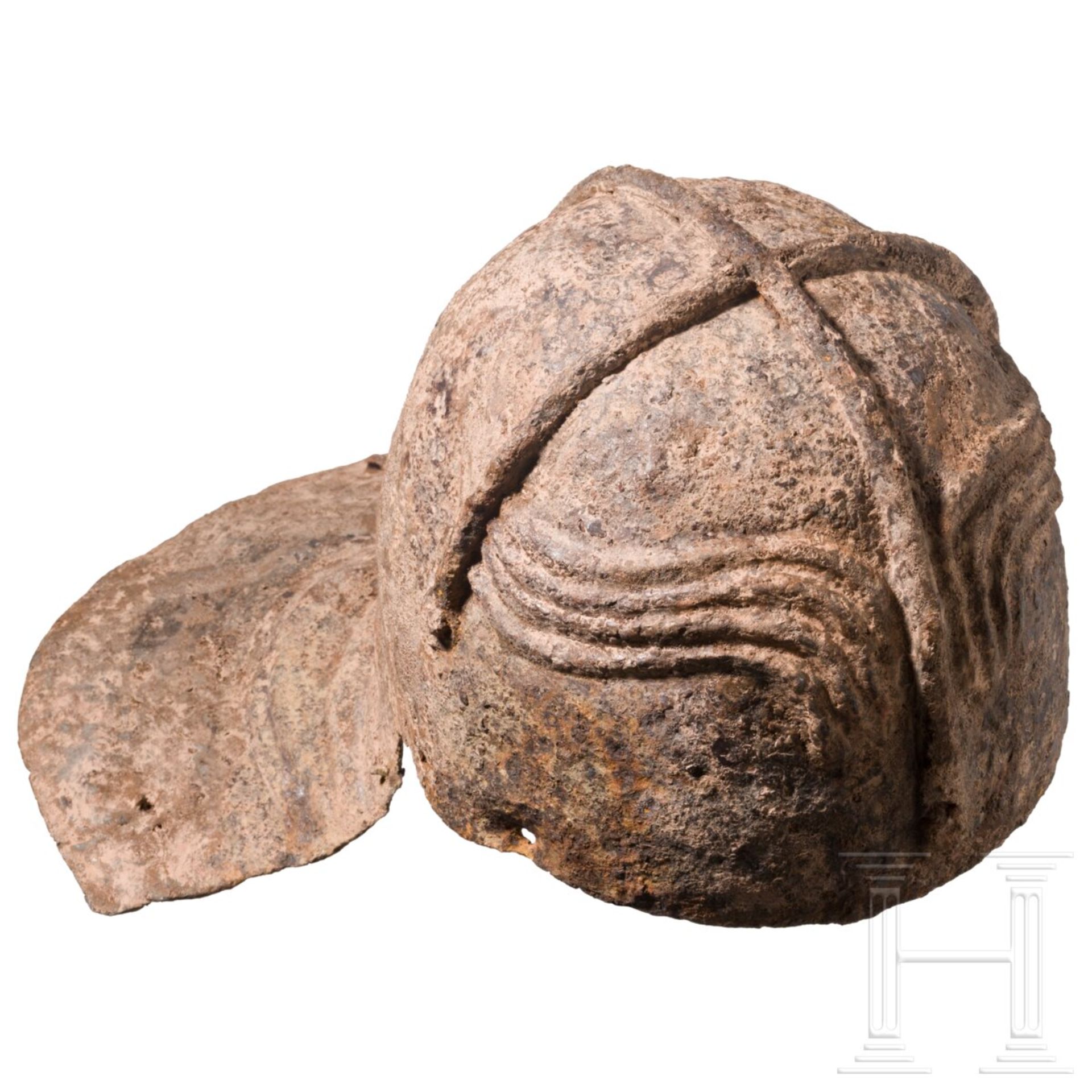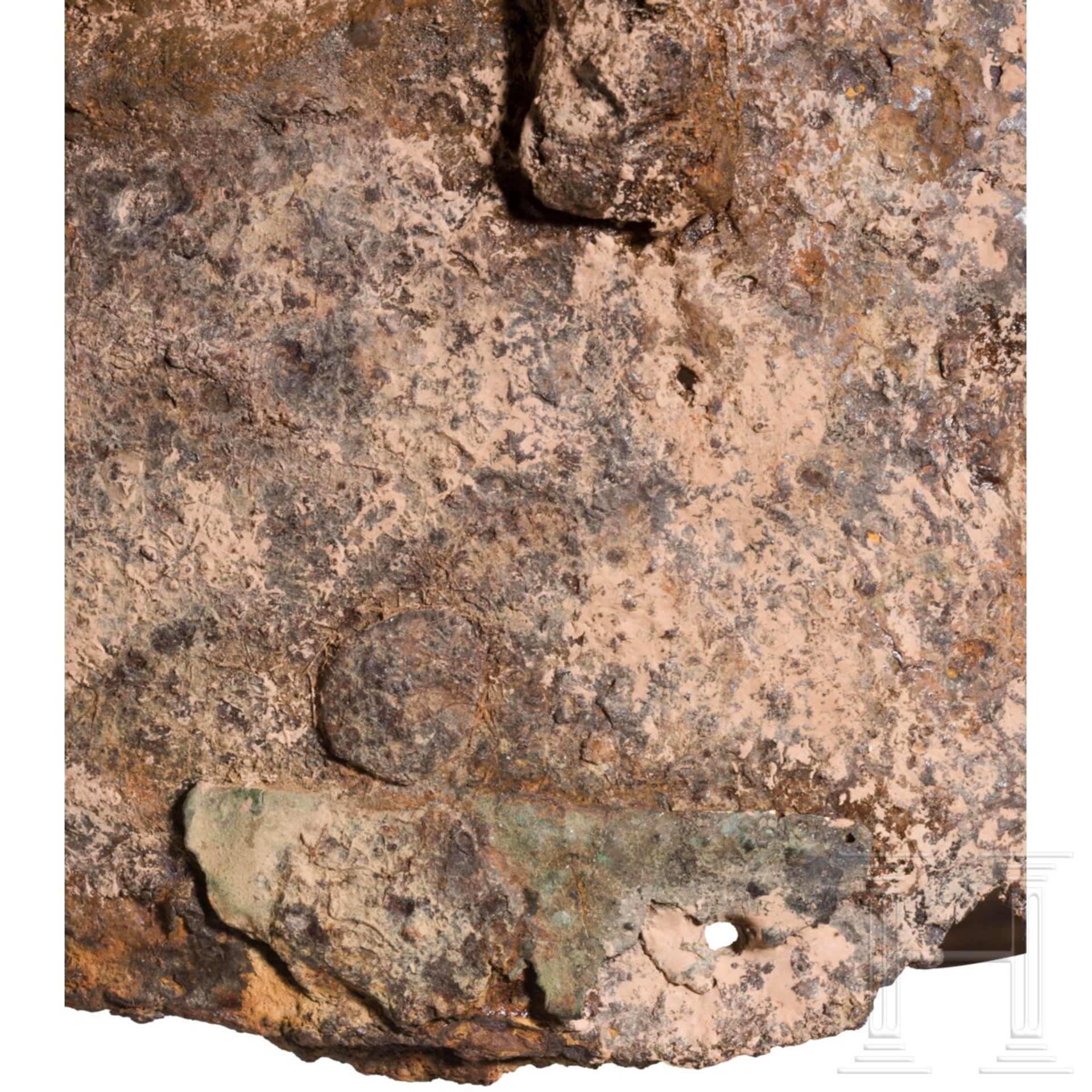41
Römischer Eisenhelm, trajanisch, frühes 2. Jhdt. n. Chr.
Helm vom Typus Weisenau mit halbkugeliger Kalotte, die in der hinteren Hälfte ca. 3,5 cm tief nach unten ausgezogen ist und dort vier von innen nach außen gedrückte, waagrechte Rippen aufweist. Darunter der leicht schräg nach unten gezogene, breite Nackenschirm, der, gleichfalls von innen nach außen gedrückt, nahe der Kalotte eine weitere Rippe aufweist, gefolgt von je zwei aufeinander folgenden Bögen in der linken und rechten Hälfte des Nackenschirms. Zwei seichte Ausschnitte für die oberen Ohrenkante in der Kalotte direkt vor dem Übergang zum Nackenschirm. Die Ohrenausschnitte und die hinten tiefergezogene Kalotte am Rand mit Nietlöchern versehen, die zur Befestigung von Beschlägen zum Schutz der Ohren dienten und senkrecht von der Kalotte abstehend Randleisten rings um den Ohrenausschnitt hatten. In den Nietlöchern (je drei auf jeder Seite) noch teilweise bronzene Nieten erhalten. Das vordere dritte Loch diente zugleich zur Befestigung eines breiten, flachen Bronzebandes rings um den unteren Rand der vorderen Kalottenhälfte. Ein kleiner Teil dieses Bronzebandes mit von innen her gepunzter Buckelzier noch auf der linken Helmseite erhalten. Oberhalb der Stirn in linker und rechter Hälfte der Kalotte die für diesen Helmtyp typischen, flügelartig geschwungenen Rippen, je vier übereinander. Der Helm wurde sekundär in antiker Zeit mit zwei massiven, gekreuzten Eisenbügeln versehen, die an den abgeplatteten Enden mit der Kalotte durch Eisennieten verbunden sind. Der Querbügel ist dabei über die Enden des "Flügeldekors" oberhalb der Stirn gelegt. Derartige Bügel sind aufgrund entsprechender Fundvorkommen als Innovation während der Zeit der Dakerkriege interpretiert worden, um die Kalotte gegen spezifische Waffeneinwirkungen zu schützen (u.a. wurde die dakische Falx, ein langes, sichelartiges Schwert, ins Spiel gebracht, das mit seinem gebogenen, spitzen Ende auch die Eisenkalotten punktuell durchschlagen konnte). Zahlreiche Helme seien während der Dakerfeldzüge mit dieser Vorrichtung nachgerüstet worden. Der Helm hat weiterhin je einen Bronzeniet in der Mitte der vier Segmente der Kalotte, die durch die Kreuzbügel entstanden sind, und in den vorderen Enden des Nackenschirms. Diese dienten wohl der Befestigung von Bronzebeschlägen, wie sie bei späteren Varianten der Helme vom Typ Weisenau vorkommen. Die Beschläge selbst sind nicht mehr erhalten. Eine Schlaufe aus Eisenband in der Mitte des Nackenschirms am äußeren Rand diente wohl zur Aufhängung des Helms, ähnlich wie Tragebügel, die von anderen Helmen her bekannt sind. Vor den Ohrenausschnitten sind auf der Innenseite ehemals zwei nach oben spitz zulaufende Eisenblechschlaufen mit zwei Nieten befestigt, von denen nur die linke erhalten ist. In dieser steckt noch eine Achse, um die einst das vordere und hintere Ende einer Wangenklappe umgebördelt war, um mit der Blechschlaufe ein Scharnier zu bilden. Der Helm lässt sich u.a. gut mit Exemplaren aus Hebron und Theilenhofen vergleichen, die ähnliche Merkmale aufweisen. Ob der Helm jemals über einen waagrechten Stirnbügel verfügte, wie er bei früheren Exemplaren dieses Typs üblich ist, darf bezweifelt werden. Wahrscheinlich hatte er eher wie der Theilenhofener Helm nur ein bronzenes, flaches Stirnband, zumal der Längsbügel beim hier vorgestellten Helm vorne weit nach unten bis nahe an die Stirn gezogen ist (beim Helm von Hebron mit waagrechten Stirnbügel endet der Längsbügel deutlich vorher im oberen Teil der Kalotte, allerdings auch beim Theilenhofener Helm). Sehr gut erhaltener römischer Helm des frühen 2. Jahrhunderts n. Chr. mit vielen interessanten technischen Merkmalen. Die hier noch eher improvisierten Kreuzbügel stehen am Anfang einer Entwicklung, die schließlich zu den serienmäßig produzierten Helmen vom Typus Niederbieber mit massiven, ungleich höher aufragenden Kreuzbügeln führt. Abgesehen von den fehlenden Wangenklappen hervorragend erhaltener und fachmännisch restaurierter Eisenhelm mit nur minimalen Ergänzungen. Länge 33 cm, maximale Breite 23 cm, Höhe ca. 25 cm. Provenienz: Süddeutsche Privatsammlung. In den 80er Jahren übernommen aus dem Besitz des Vaters |
A Roman iron helmet, Trajanic period, early 2nd century A.D.
Helmet of the Weisenau type with a hemispherical calotte, which extends downwards in the back half to a depth of approx. 3.5 cm and there has four horizontal ribs pressed from the inside out. Below this is the wide neck guard, which is pulled slightly downwards at an angle. This has another rib, also pressed from the inside outwards, near the calotte, followed by two consecutive arches in the left and right halves of the neck guard. Two shallow cutouts for the upper edges of the ears in the calotte directly in front of the transition to the neck guard. The ear cutouts and the calotte's part that was lowered at the back, had rivet holes on the edge, which were used to attach fittings to protect the ears and had edge strips around the ear cutout that stood vertically from the calotte. Some bronze rivets are still preserved in the rivet holes (three on each side). The third hole on the front also served to attach a broad flat bronze band around the lower edge of the front half of the calotte. A small part of this bronze band ornamented with point punches from the inside is still preserved on the left side of the helmet. Above the forehead in the left and right halves of the calotte are the wing-like curved ribs typical of this helmet type, four on top of each other. In ancient times, the helmet was also provided with two massive, crossed iron bars, which were connected to the calotte at the flattened ends by iron rivets. One cross bar is placed over the ends of the "wing decoration" above the forehead. Due to corresponding finds such bars have been interpreted as an innovation during the time of the Dacian Wars in order to protect the calotte against specific weapon effects (among other things, the Dacian falx, a long, sickle-like sword, was brought into play; it was able to break through the calotte with its curved, pointed end). Numerous helmets were retrofitted with this device during the Dacian campaigns. The helmet also has a bronze rivet in the middle of the four segments of the calotte created by the cross bars and in the front ends of the neck guard. These were probably used to attach bronze fittings, as found in later variants of the Weisenau type helmets. The fittings themselves are no longer preserved. A loop made of iron band in the middle of the outer edge of the neck guard was probably used to hang the helmet, similar to carrying handles that are known from other helmets.
In front of the ear cutouts, two iron sheet loops that tapered upwards were fastened with two rivets on the inside, of which only the left one has been preserved. There is also an axle in this, around which the front and rear ends of a cheek guard were once flanged to form a hinge with the sheet metal loop.
The helmet can be compared well with specimens from Hebron and Theilenhofen (among others), which have similar characteristics. It is doubtful whether the helmet ever had a horizontal forehead bar, as is typical of earlier examples of this type of helmet. Like the Theilenhofen helmet, it probably only had a bronze, flat headband, especially since the longitudinal bar on the helmet presented here is drawn far down at the front, close to the forehead (in the case of the helmet from Hebron with a horizontal forehead bar, the longitudinal bar ends significantly earlier in the upper part of the calotte, but also on the Theilenhofen helmet without such a bar).
Very well preserved Roman helmet from the early 2nd century A.D. with many interesting technical features. The cross bars, which are still somewhat improvised here, are at the beginning of a development that ultimately leads to the serially produced Niederbieber type helmets with massive, much higher cross bars.
Apart from the missing cheek guards, an excellently preserved and professionally restored iron helmet with only minimal completions.
Length 33 cm, maximum width 23 cm, height approx. 25 cm.
Provenance: German private collection. Taken over from the father's property in the 80s
Condition: II -
Helm vom Typus Weisenau mit halbkugeliger Kalotte, die in der hinteren Hälfte ca. 3,5 cm tief nach unten ausgezogen ist und dort vier von innen nach außen gedrückte, waagrechte Rippen aufweist. Darunter der leicht schräg nach unten gezogene, breite Nackenschirm, der, gleichfalls von innen nach außen gedrückt, nahe der Kalotte eine weitere Rippe aufweist, gefolgt von je zwei aufeinander folgenden Bögen in der linken und rechten Hälfte des Nackenschirms. Zwei seichte Ausschnitte für die oberen Ohrenkante in der Kalotte direkt vor dem Übergang zum Nackenschirm. Die Ohrenausschnitte und die hinten tiefergezogene Kalotte am Rand mit Nietlöchern versehen, die zur Befestigung von Beschlägen zum Schutz der Ohren dienten und senkrecht von der Kalotte abstehend Randleisten rings um den Ohrenausschnitt hatten. In den Nietlöchern (je drei auf jeder Seite) noch teilweise bronzene Nieten erhalten. Das vordere dritte Loch diente zugleich zur Befestigung eines breiten, flachen Bronzebandes rings um den unteren Rand der vorderen Kalottenhälfte. Ein kleiner Teil dieses Bronzebandes mit von innen her gepunzter Buckelzier noch auf der linken Helmseite erhalten. Oberhalb der Stirn in linker und rechter Hälfte der Kalotte die für diesen Helmtyp typischen, flügelartig geschwungenen Rippen, je vier übereinander. Der Helm wurde sekundär in antiker Zeit mit zwei massiven, gekreuzten Eisenbügeln versehen, die an den abgeplatteten Enden mit der Kalotte durch Eisennieten verbunden sind. Der Querbügel ist dabei über die Enden des "Flügeldekors" oberhalb der Stirn gelegt. Derartige Bügel sind aufgrund entsprechender Fundvorkommen als Innovation während der Zeit der Dakerkriege interpretiert worden, um die Kalotte gegen spezifische Waffeneinwirkungen zu schützen (u.a. wurde die dakische Falx, ein langes, sichelartiges Schwert, ins Spiel gebracht, das mit seinem gebogenen, spitzen Ende auch die Eisenkalotten punktuell durchschlagen konnte). Zahlreiche Helme seien während der Dakerfeldzüge mit dieser Vorrichtung nachgerüstet worden. Der Helm hat weiterhin je einen Bronzeniet in der Mitte der vier Segmente der Kalotte, die durch die Kreuzbügel entstanden sind, und in den vorderen Enden des Nackenschirms. Diese dienten wohl der Befestigung von Bronzebeschlägen, wie sie bei späteren Varianten der Helme vom Typ Weisenau vorkommen. Die Beschläge selbst sind nicht mehr erhalten. Eine Schlaufe aus Eisenband in der Mitte des Nackenschirms am äußeren Rand diente wohl zur Aufhängung des Helms, ähnlich wie Tragebügel, die von anderen Helmen her bekannt sind. Vor den Ohrenausschnitten sind auf der Innenseite ehemals zwei nach oben spitz zulaufende Eisenblechschlaufen mit zwei Nieten befestigt, von denen nur die linke erhalten ist. In dieser steckt noch eine Achse, um die einst das vordere und hintere Ende einer Wangenklappe umgebördelt war, um mit der Blechschlaufe ein Scharnier zu bilden. Der Helm lässt sich u.a. gut mit Exemplaren aus Hebron und Theilenhofen vergleichen, die ähnliche Merkmale aufweisen. Ob der Helm jemals über einen waagrechten Stirnbügel verfügte, wie er bei früheren Exemplaren dieses Typs üblich ist, darf bezweifelt werden. Wahrscheinlich hatte er eher wie der Theilenhofener Helm nur ein bronzenes, flaches Stirnband, zumal der Längsbügel beim hier vorgestellten Helm vorne weit nach unten bis nahe an die Stirn gezogen ist (beim Helm von Hebron mit waagrechten Stirnbügel endet der Längsbügel deutlich vorher im oberen Teil der Kalotte, allerdings auch beim Theilenhofener Helm). Sehr gut erhaltener römischer Helm des frühen 2. Jahrhunderts n. Chr. mit vielen interessanten technischen Merkmalen. Die hier noch eher improvisierten Kreuzbügel stehen am Anfang einer Entwicklung, die schließlich zu den serienmäßig produzierten Helmen vom Typus Niederbieber mit massiven, ungleich höher aufragenden Kreuzbügeln führt. Abgesehen von den fehlenden Wangenklappen hervorragend erhaltener und fachmännisch restaurierter Eisenhelm mit nur minimalen Ergänzungen. Länge 33 cm, maximale Breite 23 cm, Höhe ca. 25 cm. Provenienz: Süddeutsche Privatsammlung. In den 80er Jahren übernommen aus dem Besitz des Vaters |
A Roman iron helmet, Trajanic period, early 2nd century A.D.
Helmet of the Weisenau type with a hemispherical calotte, which extends downwards in the back half to a depth of approx. 3.5 cm and there has four horizontal ribs pressed from the inside out. Below this is the wide neck guard, which is pulled slightly downwards at an angle. This has another rib, also pressed from the inside outwards, near the calotte, followed by two consecutive arches in the left and right halves of the neck guard. Two shallow cutouts for the upper edges of the ears in the calotte directly in front of the transition to the neck guard. The ear cutouts and the calotte's part that was lowered at the back, had rivet holes on the edge, which were used to attach fittings to protect the ears and had edge strips around the ear cutout that stood vertically from the calotte. Some bronze rivets are still preserved in the rivet holes (three on each side). The third hole on the front also served to attach a broad flat bronze band around the lower edge of the front half of the calotte. A small part of this bronze band ornamented with point punches from the inside is still preserved on the left side of the helmet. Above the forehead in the left and right halves of the calotte are the wing-like curved ribs typical of this helmet type, four on top of each other. In ancient times, the helmet was also provided with two massive, crossed iron bars, which were connected to the calotte at the flattened ends by iron rivets. One cross bar is placed over the ends of the "wing decoration" above the forehead. Due to corresponding finds such bars have been interpreted as an innovation during the time of the Dacian Wars in order to protect the calotte against specific weapon effects (among other things, the Dacian falx, a long, sickle-like sword, was brought into play; it was able to break through the calotte with its curved, pointed end). Numerous helmets were retrofitted with this device during the Dacian campaigns. The helmet also has a bronze rivet in the middle of the four segments of the calotte created by the cross bars and in the front ends of the neck guard. These were probably used to attach bronze fittings, as found in later variants of the Weisenau type helmets. The fittings themselves are no longer preserved. A loop made of iron band in the middle of the outer edge of the neck guard was probably used to hang the helmet, similar to carrying handles that are known from other helmets.
In front of the ear cutouts, two iron sheet loops that tapered upwards were fastened with two rivets on the inside, of which only the left one has been preserved. There is also an axle in this, around which the front and rear ends of a cheek guard were once flanged to form a hinge with the sheet metal loop.
The helmet can be compared well with specimens from Hebron and Theilenhofen (among others), which have similar characteristics. It is doubtful whether the helmet ever had a horizontal forehead bar, as is typical of earlier examples of this type of helmet. Like the Theilenhofen helmet, it probably only had a bronze, flat headband, especially since the longitudinal bar on the helmet presented here is drawn far down at the front, close to the forehead (in the case of the helmet from Hebron with a horizontal forehead bar, the longitudinal bar ends significantly earlier in the upper part of the calotte, but also on the Theilenhofen helmet without such a bar).
Very well preserved Roman helmet from the early 2nd century A.D. with many interesting technical features. The cross bars, which are still somewhat improvised here, are at the beginning of a development that ultimately leads to the serially produced Niederbieber type helmets with massive, much higher cross bars.
Apart from the missing cheek guards, an excellently preserved and professionally restored iron helmet with only minimal completions.
Length 33 cm, maximum width 23 cm, height approx. 25 cm.
Provenance: German private collection. Taken over from the father's property in the 80s
Condition: II -
Kunst, Antiquitäten & Antiken
Auktionsdatum
Ort der Versteigerung
Shipping
In order to offer our national and international customers an even better and quicker service, we have taken the decision to have complex shipments carried out by specialist service providers only. Not only will this speed up our invoicing process, it means you receive your purchases considerably faster.
In some cases, the transportation of unusually large, fragile, particularly long or exceptionally heavy objects involved interminable price calculations to determine the optimal packing and shipping costs. This often caused enormous delays in invoicing, which understandably resulted in the dissatisfaction of our customers.
As of the 98th Auction, we no longer handle the shipping of such objects ourselves. The packaging and transportation of complex objects is now carried out by specialised forwarding companies with the required expertise, longstanding experience and necessary resources. Nonetheless, we will continue to ship all firearms directly.
Once again, you will receive your invoice directly after the sale has closed. If the invoice includes shipping costs, Hermann Historica will be handling the transportation. However, if shipping is not specified on the invoice, you must make your own delivery arrangements. We can recommend a number of reputable companies with whom we have worked successfully in the past. They are extremely professional and efficient in arranging for the goods to be picked up, then packed and shipped. These companies also handle customs clearance for export outside the EU. We will issue the necessary export permits for cultural artefacts and firearms.
On request, we are happy to obtain quotes for shipping from these partners on your behalf. Naturally, you may entrust your objects to another forwarding agent if you prefer, provided the carrier also offers packaging services.
Our recommended partners are listed below. If you have any further questions, please send an email with the subject "Shipping" to contact@hermann-historica.com.
Kind regards,
The Hermann Historica Team
Please always write "Shipping on behalf of Hermann Historica" in the subject line when contacting our partners.
- MBE Bergkirchen: https://antique-muc.de/en/
- M2Logistik, Markt Schwaben: service@m2logistik.de, +49 8121 2230-0
- Hasenkamp München: fineart@hasenkamp.de
Important shipping information
Due to changed regulations it is unfortunately no longer possible to send any kind of firearms from Germany to foreign destinations by regular mail service. We will, if possible, organise international shipping through forwarding agents or specialised courier services, however, with the consequence of noticeably higher shipping costs.
Wichtige Informationen
Zu Aufgeld und Mehrwertsteuer prüfen Sie bitte das jeweilige Los.
For buyer’s premium and VAT please check particular lot.
AGB
Terms & Conditions
The auction process shall be subject to our General Auction Terms and Conditions. These terms form an integral part of the resulting contracts. The General Auction Terms and Conditions are listed hereinafter and displayed in the auction room. Both by taking part in the auction and by submitting bids, you agree to accept the General Auction Terms and Conditions.
General Auction Terms and Conditions
- Hermann Historica GmbH (hereinafter referred to as the Auctioneer) shall by default carry out the auction as an intermediary in the name of and for the account of third parties, unless explicitly marked as acting as commission agent in its own name and on behalf of consignors, or in its own name and for its own account. The auctions may be conducted on or outside the business premises of the Auctioneer, with physical participation of bidders, by phone, online or by using any other digital or electronic media, in particular dedicated electronic auctioning platforms, limited to such platforms (“online-only”), and as “timed auctions”.
- The catalogue descriptions and any verbal statements neither constitute nor contain guarantees of any specific characteristics. All objects coming up for auction are offered as used. The lots may be viewed and examined prior to the auction. All lots are sold “as seen”, without any guarantee or liability in respect of visible or hidden defects. Once the bid has been accepted, no complaints of any kind may be taken into account. The right of withdrawal (with or without reason) as stipulated in the various consumer protection laws does not apply.
- The Auctioneer undertakes to carry out all purchase orders, whether submitted in writing, by phone, email, fax or via an electronic auctioning platform, conscientiously but without assuming liability. The Auctioneer reserves the right to decline or disregard order bids, without giving a reason. A maximum bid must be indicated when submitting an offer in writing; however, the Auctioneer will only draw on this in the amount required to outbid other prospective buyers by one increment (approximately 5 %). In case of identical bids a draw will decide. Phone bidders will be contacted before their requested lot is called if a written order corresponding to at least the starting price of the object has been received in good time. Phone bidding will only be permitted in exceptional cases for objects with a reserve of less than € 800. No liability may be accepted for transmission errors or for difficulties with the phone connection. On electronic auctioning platforms bids are submitted by clicking the platform’s “Bid” button, thus submitting the suggested amount required to outbid the previous high bid. “Classic” and “online-only” auctions are directed by an auctioneer who assigns the knock-down according to auction law, thus consumer protection rights of cancellation do not apply. In “timed auctions” the highest bid at the displayed end-time wins. The Auctioneer rules out any liability for consequential damage or loss of profit in the event the purchase order is not concluded, provided this was not caused by wilful misconduct on the part of an employee of the Auctioneer. The Auctioneer may refuse to accept any bids in which neither the object nor the amount of the bid can be clearly identified beyond doubt.
- The Auctioneer reserves the right to combine, separate, exclude, withdraw or rearrange any lot without giving a reason. The sale is concluded if no higher bid is submitted after a bid has been announced three times. The Auctioneer is entitled to accept the sale under reserve. If a bid is accepted conditionally, the bidder shall be bound by his bid for 4 weeks. If the bidder is not awarded the sale without reserve within this period, the bid expires. A written invoice sent to the address provided by the buyer shall be regarded as confirmation of the acceptance of the bid. Conditionally accepted bids expire without notification or further consultation with the reserve bidder. Without giving any reason, the Auctioneer may refuse any bid submitted either in person or in writing, if said bidder is unknown to him, has not provided a sufficient deposit or satisfactory references prior to the auction. Likewise, the aforementioned right of refusal also applies to customers whose accounts have not been settled in full at the time of the auction. In the event a bid is refused, the second highest bid shall be binding. If several people offer identical bids and, after the third time of asking, no higher bid is forthcoming, a draw shall decide the successful bidder. The Auctioneer is authorised to retract his acceptance of the bid and award the lot immediately in favour of a particular bidder at his discretion or to offer the object again if a higher bid made at the right time was erroneously overlooked or if any doubts arise regarding the sale. If the highest bidder wishes to withdraw his bid, the Auctioneer is entitled to accept his bid nevertheless with all consequent rights; however, he may also accept the second highest bid offered or repeat the whole call. At the bidders’ request, any lot that initially remained unsold may be offered again and sold during the day of the auction, or may be transferred into a subsequent online-only auction.
- The successful bidder is obligated to pay the purchase price to the Auctioneer. The Auctioneer is authorised by the consignor to assert his rights arising from the sale. Prospective buyers submit bids in their own name and for their own account. The purchase price comprises the bid amount, a 29.5 % premium thereof, when bidding through a third-party auction platform their commission (usually within a range of 2 % to 5 %), and the costs of insurance, packaging and shipping, if the Auctioneer is commissioned to ship the lots. If the Auctioneer is acting as an intermediary, both the premium and the fees for insurance, packaging and shipping include statutory VAT. The amount of the hammer price shall be determined on the basis of the auction record. The purchase price is due as soon as the bid is accepted and is payable in cash and in Euros. The Auctioneer expressly refers to his duty to verify customer’s ID according to the German Money Laundering Act. For credit transfers or payment by cheque on account of performance, the debt shall only be deemed to be settled when the purchase price has been credited irrevocably and in full to the Auctioneer’s account. Moreover, foreign notes and coins or currencies will only be accepted according to the respective value amount that is finally credited to the Auctioneer’s account by the bank. Shortfalls will be payable, including any fees for cheques or banking charges incurred. Please check our respective fees for payments by credit card. If a bidder acts as an agent for a third party, both may be held personally liable for obligations arising from the contract. This also applies if the invoice is issued in the name of another customer. The Auctioneer shall be exempt therefrom. Invoices issued during or immediately after the auction are subject to confirmation and may subsequently require correction. Any discrepancies in the amount shall be payable.
- Should the buyer fail to fulfil his payment obligations within the specified time limit, he is automatically in default. As a consequence, a minimum charge of € 25 will be added to the invoice amount, along with any payment reminder and/or collection fees incurred. At the same time, interest shall accrue at 5 % above the base rate p.a. Should the buyer fail to meet his payment obligations, despite receiving a reminder, he shall be liable for the damage caused by his default. If the Auctioneer asserts his right to compensation for non-performance under section 326 BGB (German Civil Code), he is entitled to offer the item for auction again at a later date. Once another buyer is found, all rights granted to the previous buyer shall expire. If the lot is resold, the previous buyer shall be regarded as the consignor and is therefore liable to recompense the Auctioneer’s services; fees to the amount of 20 % (incl. VAT) for lots with a hammer price of € 300 and above, or 30 % (incl. VAT) for lots with a hammer price under € 300, as well as all additional costs incurred by the renewed sale of the item thus become payable. He shall have no claim to the excess proceeds. The proceeds from the new auction are to be offset against the debt of compensation on receipt of the payment or the credit by the Auctioneer in accordance with section 367 BGB. Moreover, the Auctioneer reserves the right to rescind the contract if the buyer fails to pay the purchase price in full and/or collect his purchases within a reasonable time period set by the Auctioneer. In the event of rescission, the Auctioneer is entitled to demand compensation from the buyer for non-performance. In particular, the claim for compensation includes the commission charges incurred. The Auctioneer is entitled to claim 45 % of the hammer price as flat-rate compensation without further verification. Furthermore, the Auctioneer shall be permitted to provide proof of additional damages, particularly where these are higher than the flat-rate compensation.
- All lots sold must be collected on the same day. Lots purchased through the electronic auctioning platform can only be collected once payment has been received in full. Items collected are unpacked. Transport agents mandated by the buyer must handle adequate packing, shipping, if necessary export procedures by themselves. Shipment by the seller (e.g. in case of firearms) will only be effected once payment of item(s), fees, shipping, handling, insurance, and other related fees has been received in full. All risks pertaining to the item (e.g. damage) are transferred to the buyer on acceptance of his bid. As a matter of principle, the auctioned goods may only be delivered on payment of the purchase price. Nevertheless, should an item be released prior to payment of the purchase price, the transfer of ownership shall be subject to the condition precedent of payment of the purchase price in full to the Auctioneer. Under no circumstances is the buyer entitled to resell or alter the objects in any way. If the purchased items are not collected, the Auctioneer is entitled at his discretion to store the auctioned objects at his business premises or at the premises of a third party or to ship them to the buyer, including by cash on delivery. In case of storage at the Auctioneer’s premises, the items shall be stored at the buyer’s own expense and risk from the time his bid is accepted. Storage fees are charged at 1 % of the total purchase price incl. VAT per calendar month or part thereof, with the minimum charge being € 5. Any third-party storage shall be in the name, at the expense and risk of the buyer. Storage of firearms requiring official authorisation, which are subject to a special duty of safekeeping, is charged as a lump sum of € 10 per weapon per month. To non-German residents, requiring import and export permits, storage fees will only be charged from the end of the third month after completion of the sale. If sold lots are not collected within a period of 12 months, two collection reminders notwithstanding, the Auctioneer reserves the right to offer these objects for auction once again at the expense and risk of the buyer. In this case, the buyer is regarded as a consignor. Consignment fees, interest, storage costs and other expenses shall be deducted from the proceeds of the auction. Shipping shall be effected at the buyer’s risk and expense. Items shipped by the Auctioneer shall be, at the buyer’s expense, insured against the usual transport risks. The buyer undertakes to report any discernible damage to the packaging to both the forwarding agent and the Auctioneer without delay. Defects that only become apparent on unpacking the goods must also be reported to the forwarding agent and the Auctioneer without delay, but no later than one week after delivery. No liability will be accepted for defects in case of non-compliance with this requirement. All cases of shipment by an agent commissioned by the buyer are subject to the conditions stipulated in the contract concluded between these two parties, including all fees and all risks. The Auctioneer cannot accept any liability.
- The bidder shall bear any loss or damage resulting from transmission failures, misunderstandings or errors in telephone, telegraphic, wireless, fax and electronic communications with buyers, provided said damage was not caused by wilful or gross negligence on the part of the Auctioneer or his agents.
- The Auctioneer reserves the right to exclude any person from the auction without explanation, particularly those who engage in dealing or exchange during the auction, disturb the proceedings or whose accounts have not been settled in full. This is also applicable to the registration required for participation in online auctions.
- The above conditions also apply mutatis mutandis to public sales or subsequent private sales. The post-auction sale only commences at the end of the day on which the lot in question was first offered for sale.
- The buyer may only offset claims against the Auctioneer with liabilities in the same currency and to the extent that his claims are undisputed or have been confirmed by a court of law.
- The business premises of the Auctioneer shall be the place of performance for both parties if the buyer is a registered trader or a legal entity under public law or a special fund under public law or he has his place of residence outside the Federal Republic of Germany. The auction contract and all rights and obligations arising from the business relationship between the Auctioneer and the buyer shall be exclusively governed by German law. The Uniform Law on the International Sale of Goods, the Uniform Law on the Formation of Contracts for the International Sale of Goods and the CISG – United Nations Convention on Contracts for the International Sale of Goods shall be excluded.
- With regard to sales in his own name, the Auctioneer guarantees the accuracy of the information provided in terms of the object’s origin, age, epoch, manufacturer and materials. If, within 3 years from the day of the sale, this information proves to be materially incorrect, the buyer may rescind the transaction step by step, provided that the object is unaltered and still in the condition at the time of purchase. Any doubts regarding the information provided by the Auctioneer must be asserted without delay. The Auctioneer reserves the right to examine the buyer’s statement in both an internal and a third-party review, prior to acknowledging any such claims, and to reject the complaint, as appropriate. Expert’s reports commissioned by the buyer are at his own expense. Except for such claims regarding the nature of the object, for the purpose of consumer protection, the guarantee period vis-à-vis end customers shall be 1 year from the date of purchase.
- The exclusive place of jurisdiction for all present and future claims arising from the business relationship with registered traders and for claims asserted by the Auctioneer by way of a dunning procedure shall be the registered office of the Auctioneer. The same place of jurisdiction applies if the buyer does not have a place of general jurisdiction in Germany, or has transferred his place of residence or habitual abode to a country other than Germany after conclusion of the contract, or his place of residence or habitual abode is unknown at the time legal proceedings are instituted. In these cases, except for the dunning procedure, the plaintiff may choose whether he wishes to institute legal proceedings before Munich Local Court or Munich Regional Court I.
- As long as catalogue owners, participants of the auction and bidders do not state otherwise, they guarantee that they will use items dating from the time of the Third Reich and catalogues illustrating such items only for the purposes of civil education, to avert unconstitutional movements, to promote art or science, research or teaching, the reporting about current or historical events or similar purposes (§§ 86/86a StGB - German Criminal Code). The Auctioneer, his agents and consignors shall offer and/or deliver said items only under these conditions.
- The following applies to all objects sold by the Auctioneer that contain materials from protected and endangered species: the export of these goods – including ivory, tortoiseshell, crocodile skin, rhinoceros horn etc. – from the EU and their import into non-EU countries requires a permit from the regulatory authorities of both the exportation and the importation countries. Buyers intending to import any objects made of or incorporating materials from endangered species into a country that is not a member of the European Union must check their relevant customs laws and regulations prior to bidding. On request, Hermann Historica can apply for the export/re-export document from the Bundesamt für Naturschutz (Federal Agency for Nature Conservation) in Bonn for an administration fee of € 150/lot, and can organize expert opinions upon request by the authorities at cost (example: a certificate for rhinoceros horn will usually carry a fee of 100 to 150 Euros). Import permits are the sole responsibility of the buyer. The Auctioneer cannot guarantee the issuance of an export licence, which may take up to six months. As a rule of thumb, here are some examples of recent licence applications: rhinoceros horn - no German export permits for non-EU countries; processed ivory with CITES certificate: no export beyond EU borders. US import: no commercial imports! In rare cases non-commercial imports are permitted. The inability to export or import collectibles containing material from endangered or protected animal and plant species shall not be considered sufficient reason for bidders to withdraw from the sale.
- Objects that are classified as cultural goods under Council Regulation (EC) No. 116/2009 of December 18, 2008, require a licence to be exported from Germany. This regulation refers to a multitude of items, depending on their age and value, for example archaeological objects over 100 years old and manuscripts, regardless of their value. Firearms, Antique Arms & Armour, historical and military artefacts over 50 years old usually only require an export permit if they are valued at more than € 50,000, more recent objects are generally not subject to any export restrictions. Upon request and your letter of authorization the Auctioneer can apply for any necessary export permit for a fee of € 75 per group of objects (European, Asian, African, Latin American, etc.); the approval process may take up to 6 months.
- Orders and medals of the Federal Republic of Germany and her federal states, as well as their miniatures, ribbons, buttonhole bows and ribbon clasps, may only be sold to authorised persons according to section 14 paragraph 3 of the “Gesetz über Titel, Orden und Ehrenzeichen” (Law of Titles, Orders and Honours). Authorised persons include the recipients of the awards or persons in possession of a collecting licence. The collecting licence is granted by the responsible authority upon request (responsibility is regulated differently in each federal state). According to the commentary of the law, approval of a licence may only be refused by the responsible authority if there are serious grounds for doing so. By purchasing orders and medals of the Federal Republic of Germany and her federal states, the client affirms that he has been granted a collecting licence. Bids will only be accepted under these conditions.
- Firearms requiring a German firearm certificate may only be supplied to German nationals upon presentation of valid photo ID, corresponding possession and acquisition permit, and payment of a fee of € 5 per gun for notification under the provisions of section 34 WaffG (Weapons Act). Modern firearms will only be shipped to foreign buyers on receipt of the necessary German and foreign permits. Once the buyer presents a valid import permit, the Auctioneer will apply upon request for an export permit against a variable fixed fee, increased significantly as of February 1, 2024: Exports to gun dealers in the EU: for the first 5 guns € 35, for each additional 1 to 10 guns € 25. Exports to Endusers in the EU: for the first 5 guns € 75, for each additional 1 to 5 guns € 55. Exports to Non-EU-Countries: for the first 5 guns € 50, for each additional 1 to 10 guns € 25. For exports to the US/UK via our local partners MMBI (USA) and HML (UK) special conditions apply – please ask. We reserve the right to modify these fees if changed by our authorities. If any special conditions are imposed in obtaining a valid export permit, compliance with which involves additional fees and expenses, these shall be invoiced to and paid by the buyer. The sale remains legally binding, irrespective of whether the buyer holds a corresponding acquisition/possession/import permit. In the absence of a permit, the buyer shall be liable for his bid. Buyers domiciled abroad bear sole responsibility for observing the regulations in force at their place of residence on the acquisition and possession of weapons or war material. The Auctioneer cannot be held responsible in the event of loss. Firearms do not undergo functional testing but are sold as collector’s items in the condition described. Therefore, the Auctioneer cannot assume any liability whatsoever for their fitness for use, functional reliability or accuracy. A warranty is excluded in this respect. The Auctioneer is obligated to submit firearms without a valid proof mark to the responsible authority. For historically significant weapons the Auctioneer endeavours to avoid proofing and to obtain a proofing waiver. The consignor shall bear the cost hereof or for proofing. The Auctioneer assumes no liability for damage sustained as a result of the proofing process or on the way to and from the proof house.
- If one or more of the above provisions should become invalid, in full or in part, it shall be replaced by a valid provision that most closely approximates the purpose of the invalid provision. The other provisions shall remain unaffected.
Version: 2.8 / February 01, 2024






















